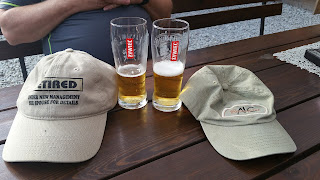 |
| Small Svend in a big square |
POLAND
I know I sang the well deserved praises of Berlin, and I stand by them, but OMG - Krakow!! What a fantastic city. You know what strikes me about Krakow, aside for the most fantastic old town square? The street musicians All this first class music playing for free on the streets, in the squares, in front of churches - oboes, violas and violins, oh my..
Casimir the Great - quick, what do you know about him? Just what I suspected, not much right? Well there must have been not much happening around the 14th century and Casimir must have been bored, because it seemed that every incredible church and castle that you see in Krakow, Casimir had a hand in having built. He also doubled the size of Poland, founded the University of Krakow, instituted a legal system, encouraged protection of the Jews to name a few accomplishments, Obviously there was no TV in the 1300's so people had to do something! I'm not sure how all this business was financed. More research is needed. My guess would be the peasants somehow got the bill.
 |
| Just another gorgeous church |
Every hour a bugler comes out of one of the tower windows high above the square and plays a melody that reminds you of "Taps" During the fourth refrain, it is cut off in mid melody, and that marks the hour. One is never quite sure from which little door the bugler will appear. Naturally many people in the square (OK, mostly tourists) look up at the church tower as the hour approaches. What's sweet and charming as that people wave at the bugler, you just want to do it. They also play this melody, known as the Hejnal Mariacki on the Polish radio at noon and I believe it is dear to every Pole.. The legend as to why the fourth refrain doesn't finish is that when the Tartars were invading the city in the 1100's the sentry who was sounding the alarm was shot in the neck. This legend may or may not be true, but it's sounds good.
 |
| Helena Rubinstien's birthplace now a lovely restaurant |
Most likely another unknown location to most of us, but yet again a wonderful old town and city square. This was one of our, -" let's see how far we get and then look for a room on airbnb" days. For a whopping $18 for the night, we slept in the apartment of a 20 something in a typical European apartment neighborhood - a series of 3-4 story apartment buildings. If you have traveled in Europe you know about the great joke they like play on Americans by saying 3rd floor when they actually mean 4th floor. They play that joke in NYC sometimes too. Anyway we trudged up to the fourth floor, Tomas was great and gave us good advice about the city. We had a lovely night walking easily to the old city, eating borscht and golumkies and moving along to Krakow the next day. Best $18 ever!
Poland has a rich history which my many years of education seems to have missed. John Sobieski ... know who he is? Apparently he was responsible for defeating the Turks in 1683 and rescuing Europe from the Ottoman Empire (finally!)
The Ottoman Empire, the Holy Roman Empire, The Tartars, The Great Schism - there are subjects that I, for one certainly need to brush up upon.
 |
Seems like an easy hike |
Another stop in Poland for a couple of days was Zakopane, a part of southern Poland that is very mountainous and beautiful. The mountain range is the western part of the Carpathians, which I first leaned about at the Adams Theater in Dorchester on a Saturday afternoon long, long ago. Bela Lugosi was the teacher. I was very happy to realize I finally reached this scary mountain range albeit not in the real vampire infested part of the eastern Carpathinans in Romania.. Although who really knows the vampire migration habits? we never expected black bears in New Jersey.
I was beginning to regret the stupid decision not to bring my beloved New Balance hiking shoes because they were so bulky, it was summer and bla, bla bla...By this time it was becoming apparent that better footwear was needed. So we found a shoe store and bought a pair of sneakers. And the next day went on a eight kilometer trek up a beautiful mountain pass, at the end of which was a dear little mountain chapel that Pope John the Second, that favorite pope of all Polish people, visited a few times. All I can say is "SHOW OFF!" I'll bet someone packed his beloved walking shoes and he didn't fall on the grass in exhaustion on the high meadow when he finally got there. And there was probably a kiosk that sold Cokes when he was there! And it probably wasn't hot August either I guess you get the hint - it was really hard. And the new shoes? You don't have to be a genius to figure that one out. The two hours up was bad enough, but the two hours down was torture. I believe that beer at the lovely outdoor cafe at sunset may have been one of the high points of my life. And I've had some pretty good high points.
 |
The far away chapel |
 |
Close to death |
 |
| Nasdrovia! |








